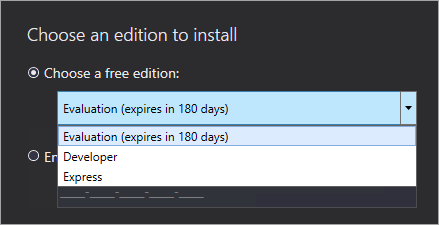Install and configure SQL Server Reporting Services
Applies to:
SQL Server Reporting Services (2017 and later) ❌ Power BI Report Server
This article helps you download, install, and configure SQL Server Reporting Services (SSRS). SSRS installation involves server components for storing report items, rendering reports, and processing of subscription and other report services. Alternatively, an administrator can install Reporting Services with Microsoft Endpoint Configuration Manager.
Download SQL Server 2022 Reporting Services from the Microsoft Download Center.
Download SQL Server 2019 Reporting Services from the Microsoft Download Center.
Download SQL Server 2017 Reporting Services from the Microsoft Download Center.
Note
Looking for Power BI Report Server? See Install Power BI Report Server.
Upgrading or migrating from a SQL Server 2016 or earlier version of Reporting Services? See Upgrade and migrate Reporting Services.
Prerequisites
Review the Hardware and software requirements for installing SQL Server. Ensure that the computer where you're installing SSRS meets the appropriate hardware and software prerequisites for the version you want to install.
Install SSRS
Use the following steps to install SSRS.
Locate
SQLServerReportingServices.exeand launch the installer.Select Install Reporting Services.
Choose an edition to install and select Next.
For a free edition, choose either Evaluation or Developer.

Otherwise, enter a product key. For more information, see Find the product key for SQL Server Reporting Services.
Accept the license terms and conditions, and then select Next.
Select Next.
Specify the installation location for the report server. Select Install to continue.
Note
The default path is
C:\Program Files\Microsoft SQL Server Reporting Services.After the installation completes, select Configure report server to launch the Report Server Configuration Manager.
Configure your report server
After you select Configure Report Server, the Report Server Configuration Manager appears. For more information, see Report Server Configuration Manager.
Follow the instructions to Create a report server database to complete the initial Reporting Services configuration process.
Create a database on a different server
If you're creating the report server database on a separate database server, change the service account for the report server to a credential recognized on the database server.
By default, the report server uses the virtual service account. Attempting to create a database on a different server might lead to the following error during the Applying connection rights step:
System.Data.SqlClient.SqlException (0x80131904): Windows NT user or group '(null)' not found. Check the name again.
To address this issue, you can change the service account to either Network Service or a domain account. Choosing Network Service applies rights in the context of the report server's computer account.
For more information, see Configure the report server service account.
Windows service
The installation creates a Windows service as a part of the process. The service displays as SQL Server Reporting Services. The service name is SQLServerReportingServices.
Default URL reservations
URL reservations are composed of a prefix, host name, port, and virtual directory:
| Part | Description |
|---|---|
| Prefix | The default prefix is HTTP. If you installed a Transport Layer Security (TLS) certificate, the installer creates URL reservations that use the HTTPS prefix. |
| Host name | The default host name is a strong wildcard (+). It specifies that the report server accepts any HTTP request on the designated port for any host name that resolves to the computer, including https://<computername>/reportserver, https://localhost/reportserver, or https://<IPAddress>/reportserver. |
| Port | The default port is 80. If you use any other port, you must explicitly add the port to the URL when you open web portal in a browser window. |
| Virtual directory | By default, the Report Server web service virtual directory is reportserver. For the web portal, the default virtual directory is reports. |
Examples of the complete URL string are:
https://+:80/reportserver: This string provides access to the report server.https://+:80/reports: This string provides access to the web portal.
Firewall
If you're accessing the report server from a remote computer and there's a firewall present, make sure you configured any firewall rules.
Open the TCP port that you configured for your web service URL and web portal URL. By default, these URLs are configured on TCP port 80.
Configure other features
You might need to configure other features for better report access and usability. You can configure integration with the Power BI service so that you can pin report items to a Power BI dashboard. For more information, see Power BI Report Server Integration (Configuration Manager).
Configure email for subscriptions processing
To configure email for subscriptions processing, see:
Set up reports from a remote computer
You can also set up the web portal so that you can access and manage reports from a remote computer. For more information, see:
Related content
For information on how to install SQL Server Reporting Services native mode, see Install Reporting Services native mode report server.
With your report server installed, begin to create reports and deploy the reports to your report server. For information on how to start with Report Builder, see Install Microsoft Report Builder.
For information on how to create reports using SQL Server Data Tools, download SQL Server Data Tools.
- For information on how to install SQL Server 2016 Reporting Services (and earlier) in SharePoint integration mode, see Install the first Report Server in SharePoint mode.
More questions? Try asking the Reporting Services forum.
Palaute
Tulossa pian: Vuoden 2024 aikana poistamme asteittain GitHub Issuesin käytöstä sisällön palautemekanismina ja korvaamme sen uudella palautejärjestelmällä. Lisätietoja on täällä: https://aka.ms/ContentUserFeedback.
Lähetä ja näytä palaute kohteelle